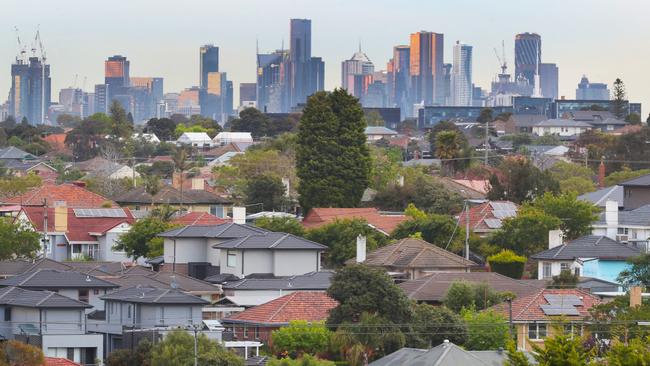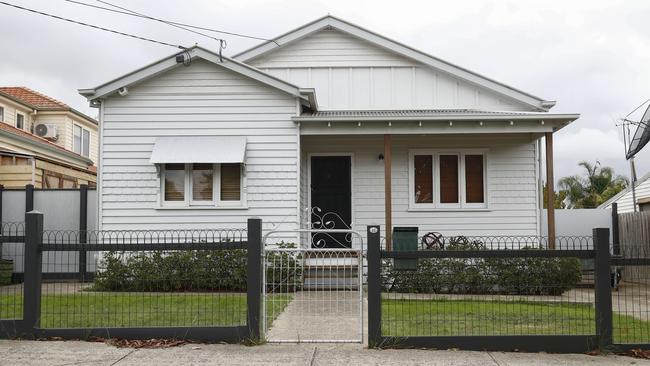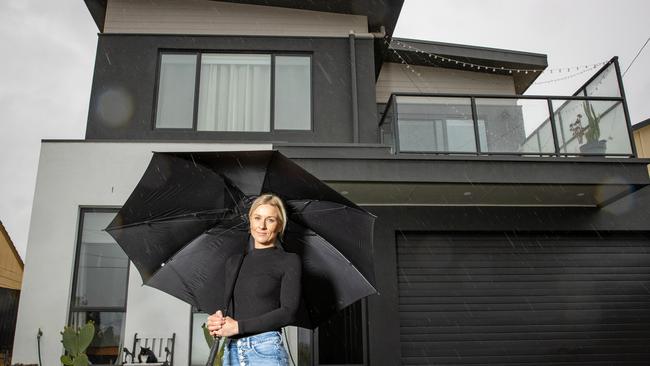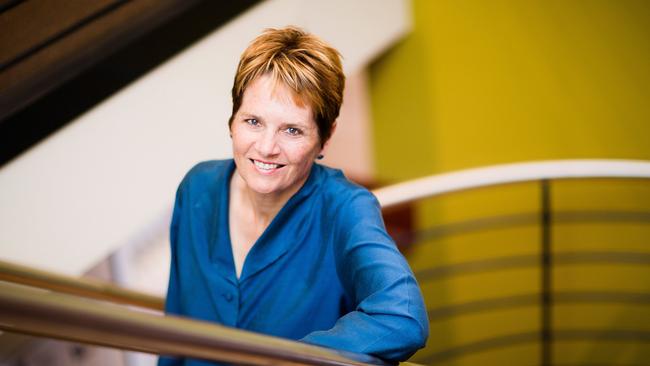Housing affordability crisis: stamp duty tweaks, tiny homes possible fixes
Saving a deposit for a typical Melbourne house now takes 14 years, with home values growing 2.5 faster than household incomes. Find out how affordable your neighbourhood is.

Property
Don't miss out on the headlines from Property. Followed categories will be added to My News.
Melbourne home values have grown at two-and-a-half times the pace of household incomes in the past 15 years, while the time it takes to save a typical house deposit in parts of the city has blown out to two decades.
These grim findings, from ANZ and CoreLogic’s latest Housing Affordability report, have emerged as experts call for stamp duty cuts and a shift towards non-conventional housing, like tiny homes, to curb the worsening affordability crisis.
The report notes “several indicators of housing costs (are) sitting at record highs across many regions of Australia”, with the home value to income ratio and deposit hurdle increasing the most.
In Melbourne, the cost of a typical house is now 10.5 times higher than gross annual household incomes – up from six in 2006. The ratio in regional Victoria is 7.5, up from 5.2.
RELATED: Melbourne’s most affordable suburbs had big value growth in 2021
Call for change to first-home buyer stamp duty concessions and exemptions
‘Ticking time bomb of inequality’ to put home ownership beyond the reach of children born today

In that period, the median house and unit value in Victoria’s capital has soared 134 per cent, clearly outpacing incomes’ 54 per cent gain.
It takes 14 years to save a 20 per cent deposit on a median-priced house in Victoria’s capital, almost double the amount of time it took 15 years ago, according to ANZ and CoreLogic.
Budding buyers in the Manningham West region face a startling 20.8 years to accrue that size deposit for a median-priced dwelling, with the time frame above 18 years in Whitehorse West, Bayside and Monash.
It has also shot up to 15 years in the Gippsland-South West and Surf Coast-Bellarine areas.
The report adds while low interest rates had ensured servicing mortgages had remained manageable, they had also “contributed to greater inequality between those that have been able to achieve home ownership, and those trying to enter the market”.
Further research by the National Housing Finance and Investment Corporation found first-home buyers on the lowest 40 per cent of incomes could only afford 10 per cent of homes on the Melbourne market.
CoreLogic head of research Eliza Owen said affordability had “deteriorated across most regions of Australia, including capital cities” during the pandemic.
“There are pockets of Victoria where prices are more affordable, notably parts of the inner-city unit segment – but that’s not necessary where people want to live and start a family,” she said.
“To the relief of potential first-home buyers, we are likely to see a downswing in the property market over the next couple of years, as these kinds of extraordinary growth levels are unsustainable.”
But peak industry bodies and economists say action is required now to aid those struggling to tie down a permanent home.
Real Estate Institute of Australia president Adrian Kelly, realestate.com.au economist Anne Flaherty and Loan Market broker Jacob Decru are among those who have called for changes to stamp duty to address deteriorating housing affordability.

Mr Kelly wants the states to discuss “a better alternative” to the tax at a national cabinet meeting, previously telling the Sunday Herald Sun some Melbourne buyers were coughing up “just under half of their year’s salary in stamp duty”.
And Ms Flaherty and Mr Decru both said the thresholds for first-home buyer stamp duty exemptions and discounts must be increased in Victoria, from $600,000 and $750,000 respectively.
Real Estate Institute of Victoria president Adam Docking urged the state government to work with the industry on measures to help people on to the property ladder, rather than slug them with taxes that were “pricing a lot of people out”.

Creating more cost-effective housing should also be on the agenda, according to Melbourne builder Nick Todd, who pivoted his residential building businesses during the pandemic to creating tiny homes.
He said non-conventional housing had never been more relevant, amid rising house prices and a Covid-driven desire for a lifestyle change, and urged councils to reconsider laws that prevented tiny homes from being installed permanently.
“They have everything a standard house has – I’m building them with full-sized ovens, a stove, dishwasher, washing machine, and a staircase,” he said.
“It’s just smaller in the sense you don’t have a massive lounge or kitchen; it’s compact.”
Sign up to the Herald Sun Weekly Real Estate Update. Click here to get the latest Victorian property market news delivered direct to your inbox.
IN DESPERATE NEED OF ‘CHEAP’ RENTALS
A lack of “cheap rentals” for low-income earners has Victoria’s peak homelessness body “extremely concerned” about the state of rental affordability.
A recent report from the National Housing Finance and Investment Corporation named Melbourne the most cost-friendly capital for renters, attributing a “modest improvement” in affordability since mid 2020 to the lack of migration caused by Covid-related border closures and lockdowns.
But the bottom 40 per cent of income earners could still only afford up to 30 per cent of properties available for rent, while a typical tenant in regional Victoria was limited to 30 per cent of listed homes. The latter figure marked a 20 per cent drop from June 2020.

“People moving from Melbourne to the regions has driven rents up and vacancy rates down. We’re extremely concerned,” Council to Homeless Persons chief executive Jenny Smith said.
“The inability to find an affordable place to live is the biggest driver of homelessness.”
Ms Smith said in the last year, about 18,000 young people reached out to homelessness services in Victoria.
“(But) too many couldn’t get the medium or long-term accommodation they need,” she said. “There just aren’t enough cheap rentals.”
She urged the federal government to support state efforts to provide “more options at the lower end of the market”.
While the Victorian government pledged a record $5.3bn towards social housing in the 2020 budget, Scott Morrison’s government has failed to make a significant investment in the sector.
It has instead initiated an inquiry into housing affordability and supply.

A Victorian government spokesperson said its $5.3bn Big Housing Build was the “largest single investment in social and affordable housing in Australia’s history”, which would see more than 12,000 new homes built to boost social housing supply by 10 per cent.
Victorian non-profit Kids Under Cover is working to reduce youth homelessness by building backyard studios in family and foster care homes. Its more than 600 studios across the state are now housing about 960 young people.
Chief executive Stephen Nash said there was “no reason” they couldn’t expand the initiative, but regular funding was needed.
“Increasing rents have created a crisis out there, and it makes sense families on low incomes would try and find the most affordable property they could, (regardless of size),” he said.
“That’s where our studio program does offer a way of alleviating that stress and overcrowding.”
TINY HOMES OFFER BIG SAVINGS
When the cost of constructing a large home for their growing family quickly rose above $1m, Paula Scully and husband Gerard instead built three tiny homes in Mallacoota for a fraction of the price.
“It saves on the environment, it saves on a lot of different materials … and they’ve got everything you need,” Ms Scully said.
This included space for their three children and two grandchildren to stay across the three “pods”.

A kitchenette with a four-burner stove, a microwave and bench, an upstairs bedroom, a full bathroom, a washing machine and dryer, and a veranda are included in the main pod, while bunk beds and additional bathroom facilities are in the other two.
Ms Scully said the trio, built by NJ Tiny Homes’ Nick Todd, cost about $250,000 in total and would allow the family more time and money for “good, old-fashioned fun”.
“It’s the future,” she added. “I think it will be something a lot of people look at because the house prices are ridiculous at the moment.”
BY THE NUMBERS
MELBOURNE
Median house and unit value vs. household income
2006: $321,534 vs. $1105
2011: $480,412 vs. $1362
2016: $583,037 vs. $1574
2021: $753,100 vs. $1706
From 2006 to 2011: 134.22% increase vs. 54.39% increase
Ratio of dwelling values to income
2006: 6 (house), 5.1 (unit)
2021: 10.5 (house), 6.9 (unit)
Years to save a 20% deposit
2006: 8 (house), 6.8 (unit)
2021: 14 (house), 9.2 (unit)
Portion of household income required to service a new mortgage
2006: 40.7% (house), 34.2% (unit)
2021: 50.8% (house), 33.3% (unit)
REGIONAL VICTORIA
Median dwelling value vs. household income
2006: $216,452 vs. $834
2011: $256,617 vs. $984
2016: $293,466 vs. $1153
2021: $483,870 vs. $1318
From 2006 to 2011: 123.55% increase vs. 58.03% increase
Ratio of dwelling values to income
2006: 5.2 (house), 4.2 (unit)
2021: 7.5 (house), 5.2 (unit)
Years to save a 20% deposit
2006: 7 (house), 5.6 (unit)
2021: 10 (house), 7 (unit)
Portion of income required to service a new mortgage
2006: 35.2% (house), 28.5% (unit)
2021: 36.4% (house), 25.3% (unit)
Source: CoreLogic ANZ Housing Affordability Report 2021
All data is for June quarter of that year


